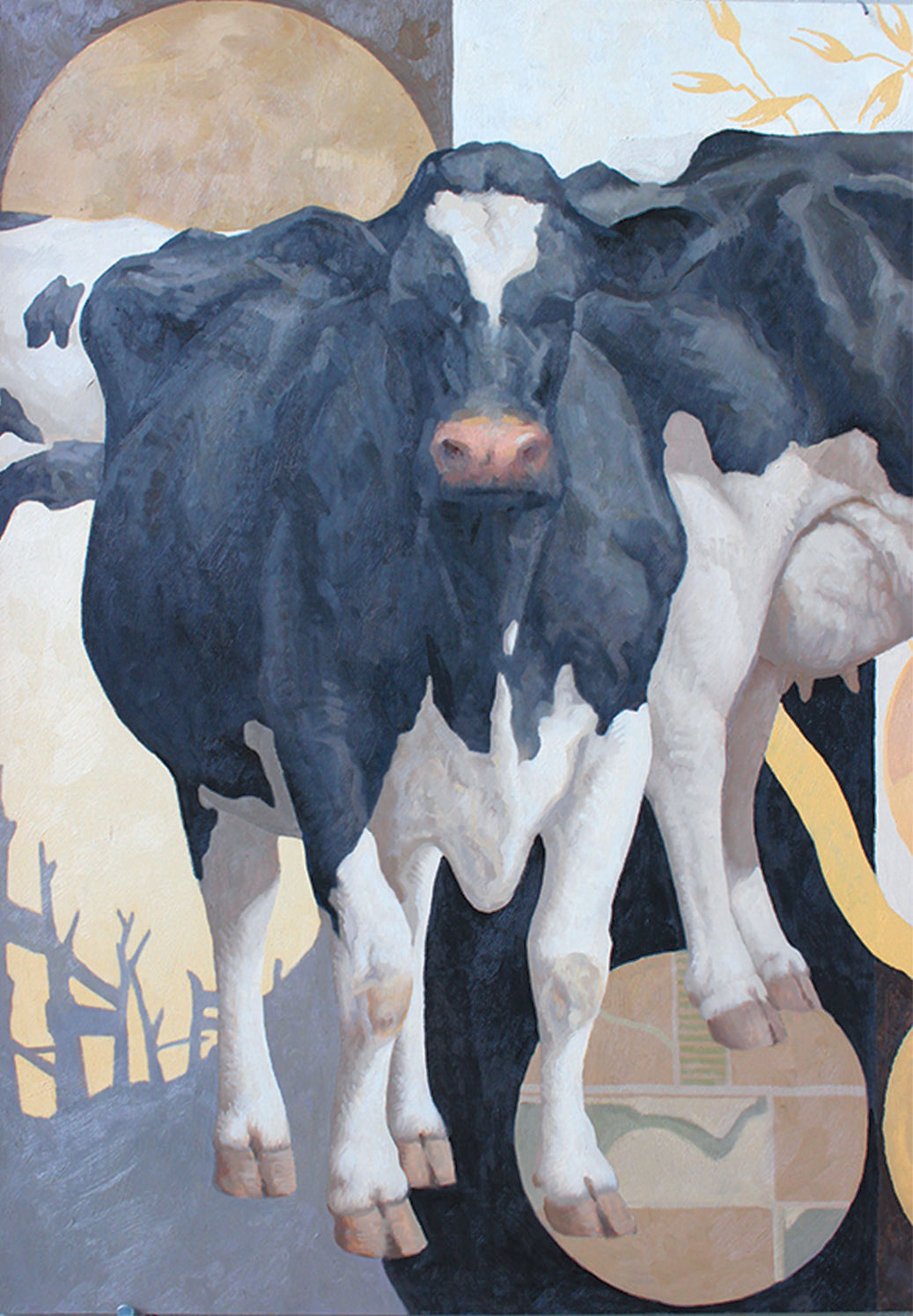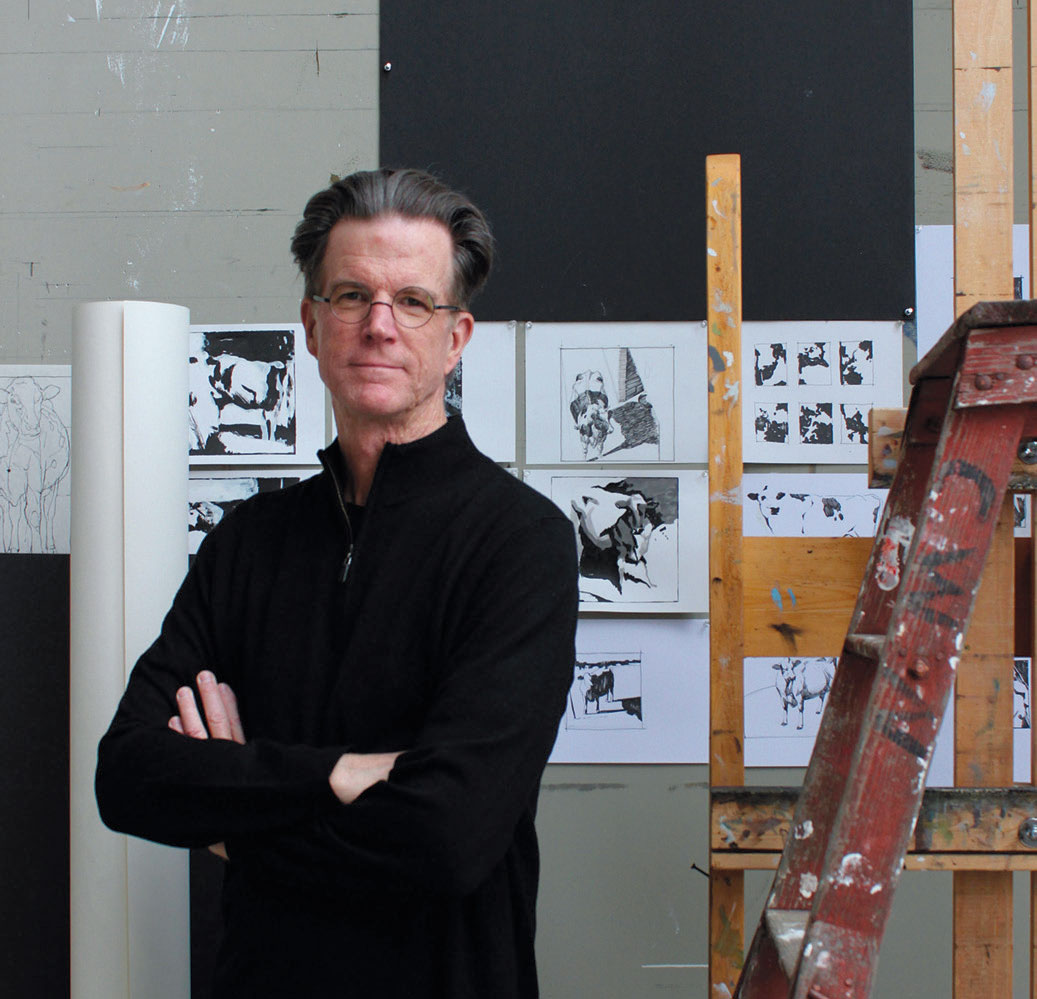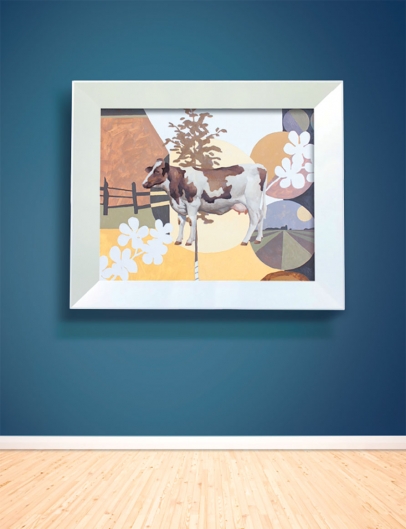From Pasture to Gallery
THE BEAUTY & SIGNIFICANCE OF COWS REFLECTED IN CRAIG BLIETZ’S WORK
It may be safe to say that few exhibits that have shown at the Museum of Wisconsin Art in West Bend are as immediately recognizable to the state’s perceived landscape as the one that opens on Oct. 13.
As you sit in artist Craig Blietz’s sunlit studio in Sister Bay and are surrounded by the large canvasses that will cover the museum’s walls, it’s hard to imagine that Blietz had been inspired by anything else than a short drive through rural Wisconsin, but that isn’t exactly the case.
“My aim is for the viewers of my work to experience and recollect the feeling of, to the extent of their intimate engagement and experience, being in the midst of a Midwestern agrarian ‘place,’” says the lanky, congenial Blietz, stressing that the scenes and elements in the exhibit “Herd” are part of the broader American landscape, as well.
Of course, the title helps give away the principal characters in the show, and it should come as no surprise to anyone familiar with Blietz’s work, and there are many of them, that they are cows.
Blietz more often than not refers to them as “cattle,” but for any of us raised in Wisconsin, we’re on a first-name basis with these seemingly relaxed, cud-chewing pasturedwellers as “cows.” For many of us who are either raised on farm or near one, they are among the earliest recognizable animals that we can identify and pronounce. How many alphabet books do you know that use anything else to identify the letter C?
“I utilize cattle imagery, primarily Holstein cows, as I feel that they are the strongest emblem representing Midwestern agrarian ‘place,’” he explains. “I also have an appreciation for their black-and-white patterned coats and the formal abstract quality that they present. The relationship that we share with cattle creates the basis for strong visual associations.”
It’s been a lengthy relationship for Blietz, spanning roughly two decades. Originally a figure and still-life artist from Illinois, the 61-year-old Blietz moved to northern Door County in 1999.
The proximity to so many cows kind of “blew the lid” off his artistic direction, especially for an artist who has been intensely driven by art history and particularly artists whose work was driven by a sense of place.

"Avena", oil on panel, 40" x 60"
“I utilize cattle imagery, primarily Holstein cows, as I feel that they are the strongest emblem representing Midwestern agrarian ‘place,’”
– Craig Blietz
He references Edgar Degas and the influence that his native Paris had on his work, as well as famed American painter Andrew Wyeth and the impact his native Pennsylvania and Maine had on him.
“Wyeth principally lived in two places in his lifetime – Chadds Ford, Pennsylvania and Cushing, Maine,” said Blietz, and Wyeth, when asked to describe the inspiration for his work, simply said, “I paint my life.”
It’s clear that Blietz sees the farm fields and pastures as his sense of place.
“I see them every time I fly over the Midwest and they present to me in their abstractness a sense of home” he said. And while cows, and now goats to some extent, land the starring roles in his works, many of the elements we associate with agriculture fi nd their way into his creations.
That is particularly the case with “Herd” as Blietz’s cows share space with barns, rustic fencing and crops set in the black, brown, and golden hues associated with the cattle and grain fi elds. Adding to the intrigue are the geometric shapes that Blietz incorporates into the works that symbolize agrarian land appropriation and irrigation patterns. And just like the cows themselves, most of the paintings are huge.
The largest painting is six feet tall by nine feet wide.
“Most of the other paintings in the group are from 30 x 60 inches up to 60 x 60,” said Blietz. “The fi guration in the paintings represents cattle, agrarian architecture, agricultural land-appropriation graphics, crops grown in the Midwest (primarily Wisconsin) and crop irrigation patterns as one would see from an airplane.”
It’s been a project more than a year and a half in the making.
“I began working on this body of work formally in March of 2017,” he said. “I will complete all the work by October of 2018.”
More than just what the cows represent in Midwest agriculture, Blietz said they are fun and interesting to paint.
“The animals are fabulous with their hide so close to their skeleton,” he said. “They are enormous and therefore intimidating physically while at the same time having this really sweet and kind disposition.”

Craig Blietz in his Sister Bay studio. Contributed photo
Blietz admits he doesn’t mind being referred to as the “cow guy.” He takes it as a compliment, especially since his work is being recognized and is popular.
A humble guy, Blietz prefers to downplay the popularity of his work when asked how they sell, but admits with a smile that they seem to find homes.
Blietz doesn’t miss his work’s correlation with food, particularly the cows which are at the heart of our dairy industry.
“We nurture them and they nurture us,” said Blietz, who said he’s been approached by friends to raise cattle on the acreage behind his studio. Of course, livestock also supply much of the meat in our diets.
“I try not to think about that,” he admits. “I would make a lousy farmer. I’d end up with a large petting zoo.”
Blietz seems more than satisfi ed with the career choice that he made. “Everyone comes into this world drawing,” he said. “As kids we do it, and then eventually some of us stop. The only thing different about me is that I just continued drawing. Essentially, a lot of what I do in the process of creating a painting is doodling. I use doodling as means towards ideation and problem solving.”
Having been a student in one of Blietz’s one-day art classes, I can understand just how masterful a doodler Craig Blietz has become.
Fortunately for all of us, Blietz has applied his skills to emphasize an aspect of our lives that so often is taken for granted and underappreciated. The life of the farmer is what much of Blietz’s work, and particularly “Herd,” is all about and it seems you’ll see more cows after he wraps up this collection of work.
“Until I find or cultivate another symbol that resonates as strongly as the cows do with agrarian place, they will remain,” he says with another of those wry smiles..
“Herd” will be shown at the Museum of Wisconsin Art in West Bend Oct. 13, 2018 – Jan. 13, 2019. It will travel from there to Tory Folliard Gallery in Milwaukee Jan. 18 — March 2, 2019.





